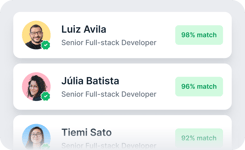Hire Remote React.js Developers Effectively in 2025
React JS is a popular JavaScript library widely used for developing dynamic and interactive user interfaces for web applications. It was developed by Facebook and is now maintained by both Facebook and a community of developers. React JS has become one of the most popular front-end frameworks in recent years due to its flexibility, ease of use, and ability to create high-performance web applications.
React JS is trusted by companies like Facebook, Instagram, and Airbnb for building fast, scalable, and user-friendly applications. Its component-based architecture and efficient data updates make it a go-to for everything from e-commerce sites handling high traffic to real-time dashboards used in finance and healthcare. When you hire a ReactJS development company that knows how to leverage these strengths, you’re not only investing in sleek, modern design but also in optimal performance that keeps users engaged. Our skilled ReactJS developers can fine-tune load times, streamline complex data flows, and deliver a smooth user experience, giving your business an edge.
Hiring React JS developers can be challenging, especially if you need to familiarize yourself with the required technical skills. In this article, we will discuss the key factors to consider when hiring React JS developers, including the technical and communication skills needed to hire top React JS developers. We will also provide some common interview questions to ask during your React developer hiring process and answer frequently asked questions about hiring React JS developers.
What to Look for When You Hire a react.js Developers
Technical Skills
Proficiency in React Framework
A skilled React developer should demonstrate a deep understanding of React's core features and functionalities. React is a popular front-end JavaScript library used for building user interfaces. It is highly efficient and flexible, making it a preferred choice for developing scalable, high-performance web applications. React.js is widely used in the industry, and its proficiency is a highly sought-after skill among developers.
Proficiency in React involves a deep understanding of its core concepts, such as components, JSX, virtual DOM, and state management. A proficient React developer should be able to use these concepts effectively to build complex UIs that are modular, reusable, and maintainable. A proficient developer should be familiar with tools and libraries such as Redux, React Router, and Axios, commonly used in React-based applications.
A proficient React developer should also have experience integrating React.js with backend technologies such as Node.js and MongoDB and javascript technologies such as using popular front-end frameworks like Bootstrap and Material UI.
Experience with Redux or Flux
When you hire offshore ReactJS developers, they should know Redux and Flux because they are essential parts of React. Both of these are state management libraries used in React applications.
Redux is a predictable state container for JavaScript apps. It is commonly used with React but also with other libraries or frameworks. Redux helps you manage the state of your application more predictably by enforcing a strict unidirectional data flow. Redux is designed to be lightweight and efficient, making it a popular choice for managing the state of large-scale applications.
Flux, on the other hand, is an application architecture pattern developed by Facebook that complements React. It is a unidirectional data flow pattern that helps to keep the code organized and maintainable. Flux has three main components: stores, actions, and views. Stores contain all the versions of the application's state, steps are responsible for updating the state, and views are the UI components that render the form. Flux is often used with React because they share the same philosophy of unidirectional data flow.
Knowing both Redux and Flux is essential for a React developer because they provide effective ways of managing the state of a React application. Understanding how to use them can help to improve the overall performance and scalability of your React application. A developer with knowledge of both Redux and Flux can create a more efficient and maintainable application.
Familiarity with React Native App Development
Familiarity with React Native and mobile app development is another valuable skill for a React developer. React Native is a framework that allows developers to build mobile apps using the same principles and tools as React. It enables developers to create native mobile apps for both iOS and Android platforms with a single codebase.
Understanding the differences between developing for the web and mobile platforms and the commonalities will be helpful when building mobile applications. Understanding the nuances of critical aspects of software development and designing user interfaces for mobile devices, such as touch input and screen sizes.
In summary, React developers who are familiar with both React development, and Native app development can provide additional value to a company by using critical skills in building both web and mobile applications and having a solid understanding of mobile user interface design principles.
Knowledge of JavaScript
A strong knowledge of JavaScript is essential for any React developer. JavaScript is the backbone of React development; building anything meaningful with React is only possible with a good understanding. React is built using JavaScript, and JavaScript is used to control everything within a React application. A React developer needs to write clean and efficient code in JavaScript, use modern JavaScript features, and be familiar with important JavaScript concepts like asynchronous programming, closures, and scopes.
Additionally, a React developer should be well-versed in the latest ECMAScript (ES) standards and features, including ES6 (ECMAScript 2015) and beyond. ES6 introduced many new features and syntax that are now considered standard in modern JavaScript development, such as arrow functions, template literals, destructuring, and the spread operator. Familiarity with these features will allow a developer to write more concise and readable code, which is critical for the maintainability and scalability of a React application.
Proficiency with HTML and CSS
Proficiency in HTML and CSS is also essential for a React.js developer. React js is a user interface (UI) library, and as such, it is often used to build the front end of web applications. To create a functional and visually appealing UI, all React JS developers must understand HTML and CSS strongly.
HTML (Hypertext Markup Language) is used to create web pages. It provides the web page's structure, including headings, paragraphs, images, and links. In a React.js project, HTML is used to create the skeleton of the web page, with the various React components being inserted into the appropriate places.
CSS (Cascading Style Sheets) is a stylesheet language used to describe the presentation of a web page. CSS adds colours, fonts, layouts, and other visual styles to a web page. In a React.js project, CSS styles the various React components, giving them an appropriate look and feel.
A React.js developer must have a solid understanding of HTML and CSS, including the latest HTML5 and CSS3 standards. They should be able to write clean and well-structured HTML and CSS code that follows best practices, such as using semantic HTML and separating content from the presentation with CSS. They should also have experience with responsive design and be able to create UI layouts that work well on different devices and screen sizes.
Experience with Webpack and Babel
Another important technical skill for React developers is experience with Webpack and Babel. Webpack is a popular module bundler that allows developers to manage dependencies and bundle their code into a single file. On the other hand, Babel is a tool that transpires modern JavaScript code into a version that older browsers can understand.
React applications often require a lot of configuration, support, and maintenance services Webpack and Babel are essential tools for ensuring everything works properly. A React developer proficient with Webpack and Babel can set up a project from scratch, configure it to use the latest features of JavaScript, and optimize it for performance.
In addition to being able to configure Webpack and Babel, a React developer should also be familiar with the various plugins and loaders that can be used to extend their functionality. For example, a React developer might use the CSS loader to import stylesheets into their application or the image loader to load images dynamically. Using the right tools and configurations, a React developer can create efficient and performant applications that are easy to maintain and extend.
Knowledge of Testing Frameworks
When hiring a React.js developer, solid testing framework knowledge is necessary. This includes both unit testing and integration testing. Unit testing involves testing individual pieces of code, such as functions or modules, to ensure they function as intended. Integration testing, on the other hand, pushes the interactions between various system components to ensure they work together seamlessly.
Several testing frameworks are available for React.js development, including Jest, Enzyme, and Mocha. Jest is a popular testing framework maintained by Facebook and is widely used within the React.js community. The enzyme is a testing utility that can interact with React components and simulate user interactions. Mocha is a flexible testing framework used with various libraries and tools.
A strong React.js developer should have experience using one or more of these testing frameworks and be able to write practical tests to ensure the stability and functionality of their code. Additionally, they should be familiar with best practices for testing React.js components and be able to incorporate testing into their development process and workflow.
Understanding of Git and Version Control
Git is a version control system allowing developers to track changes in their source code base over time. It's an essential tool for collaboration, allowing multiple developers to work on the same codebase and manage potential conflicts.
When hiring React developers, it is essential to ensure they have a strong understanding of Git and version control. This includes familiarity with Git commands and workflows, such as branching, merging, and resolving conflicts. Additionally, they should be comfortable using Git with remote repositories, such as GitHub or GitLab.
Version control is vital in software development, as it provides a way to roll back changes, track progress, and collaborate with others. A developer with experience with Git and version control can work more efficiently, communicate more effectively with other developers on their team, and ensure their code is well-documented and organized.
Knowledge of Performance Optimization Techniques
Regarding web development, performance is a critical aspect that can significantly impact code quality and the user experience. As such, a strong React developer should have a solid understanding of performance optimization techniques. This includes:
Code Splitting: One way to optimize the performance of a React application is by using code splitting, which involves breaking the code into smaller, more manageable chunks. This can reduce the application's initial load time and improve performance.
Memoization: Memoization is a technique that involves caching the results of a function so that it can be reused later on. This can be particularly useful in React applications, where components often must be rerendered as data changes. By caching the results of expensive operations, developers can avoid unnecessary computations and improve the performance of their applications.
Lazy Loading: Lazy loading involves loading certain parts of a web page only when needed rather than loading everything simultaneously. This can help improve React applications' performance by reducing the amount of data that needs to be loaded upfront.
Server-side Rendering: Server-side rendering involves rendering a React application on the server before sending it to the client. This can help improve the application's performance by reducing the work needed on the client side.
Performance Monitoring: Finally, a strong React developer should be familiar with performance monitoring tools that can help to identify performance bottlenecks in an application. This includes tools like Chrome DevTools, which can analyze network activity, CPU usage, and other performance metrics. Using these tools, developers can identify and fix performance issues before they become user problems.
Communication Skills
When considering a React developer for a position, evaluating their communication skills is as important as assessing their technical abilities. Effective communication is critical for developers working on complex projects, as they must collaborate with different stakeholders to ensure project success.
The communication skills to look for include clear and concise communication, active listening, a collaborative working style, professionalism, adaptability, and cultural fit. Additionally, problem-solving skills are essential, and developers should be able to communicate their approach to problem-solving and work collaboratively to find solutions. Strong communication skills are necessary for a React developer to work effectively as part of a team and contribute to project success.
Ability to Learn New Technologies
It's also vital to assess a candidate's ability to learn new technologies quickly when hiring ReactJS developers. The technology landscape is constantly evolving, and top ReactJS developers must be able to keep up with the latest trends and tools to remain competitive. A strong ReactJS developer should have a strong interest in technology and be willing to learn and improve their skills continuously. They should be able to quickly learn new programming languages, frameworks, libraries, and tools as needed for their projects.
A strong ability to learn new technologies quickly is an essential soft skill for any ReactJS developer. By assessing a candidate's proficiency in soft skills in this area, you can ensure they can continuously learn and adapt to changes in the technology landscape, which is necessary for building successful and innovative TypeScript applications.
Ability to Write Clean, Maintainable Code
For React developers, writing clean and maintainable code is essential. Clean code is well-organized, follows established best practices, and eliminates unnecessary complexity and duplication. Maintaining code that is clean and easy to read can save time in the long run, as it reduces the amount of time spent on code maintenance and troubleshooting. React developers should follow consistent naming conventions, modularity, DRY (Don't Repeat Yourself), comments and documentation, and testing.
Writing clean and maintainable code leads to more efficient and effective development processes, reduces errors and bugs, and makes it easier for other developers to work with the codebase. Writing clean and maintainable code is an invaluable skill for React developers.
Experience with TypeScript
A skilled ReactJS developer with TypeScript experience brings a lot to the table, especially for large projects. By catching errors at compile time, TypeScript makes code more reliable and easier to maintain. When you hire dedicated ReactJS developers, their TypeScript expertise can enhance team collaboration with clear type definitions, making data flow simpler to follow. This doesn’t just benefit code quality; it makes onboarding smoother and reduces bugs, allowing your team to stay focused on delivering results.
Understanding of RESTful APIs and GraphQL
Since modern web applications rely heavily on data fetching, a ReactJS developer needs to know their way around RESTful APIs and GraphQL. Mastering asynchronous requests, handling different response types, and managing state efficiently is key to building fast, dynamic UIs. When you hire ReactJS app developers, look for those with experience in tools like Axios for REST and Apollo Client for GraphQL. This ensures your application will integrate seamlessly with backend services and deliver the best user experience.
State Management Experience
Effective state management is a must for high-performing React applications. While Redux is popular, a well-rounded ReactJS developer should also know alternatives like MobX, Recoil, or the Context API with Hooks. Each tool has its strengths, so understanding when to use each one is invaluable. For example, smaller projects may work best with React’s Context API, while more complex applications might benefit from Redux. When you hire a ReactJS developer with experience across state management libraries, they can tailor their approach to your project’s specific needs, enhancing both performance and maintainability.
Knowledge of SEO Principles and Server-Side Rendering (SSR)
Although React is client-side, having a solid SEO strategy is still important, especially for content-driven sites. A ReactJS developer with knowledge of server-side rendering (SSR) using frameworks like Next.js can make your app more SEO-friendly, making it easier for search engines to find. This is especially useful when you hire a ReactJS development company since SEO can play a big role in your web app’s success. Plus, SSR skills mean faster load times and better user experience, leading to higher engagement and better results.
Collaboration with Design Teams
A ReactJS developer needs to work closely with UI/UX designers to turn ideas into functional, user-friendly components. Familiarity with tools like Figma, Sketch, or Adobe XD helps them translate static designs into interactive interfaces that look and feel just right. When you hire offshore ReactJS developers or hire remote ReactJS developers, strong communication skills are a must to keep everyone aligned, no matter the distance. This ensures the final product meets both design and functional expectations, a key factor when you hire ReactJS developers for your projects.
Top ReactJS Developer Interview Questions
Explain the concept of JSX in React and its benefits.
JSX is a syntax extension for JavaScript that allows you to write HTML-like code in your JavaScript files. It makes it easier to write and manage UI components in React. With JSX, you can write code that looks like HTML but is JavaScript under the hood. The benefits of JSX include the following:
- It simplifies the process of writing UI code in React.
- It provides a more readable and understandable syntax for creating UI components.
- It allows you to mix HTML and JavaScript in one file, making it easier to manage your code.
- It makes it easier to see how your UI will look since the code closely resembles the final HTML output.
Asking this question evaluates the developer's understanding of the syntax and concepts of the ReactJS app. It helps evaluate the candidate's knowledge of JSX, an essential part of ReactJS app development. A strong sense of JSX shows that the candidate is proficient in the ReactJS platform and can use it to develop efficient, high-quality applications.
What is virtual DOM, and how does it improve performance in React?
The virtual DOM is a lightweight copy of the actual DOM (Document Object Model) in a React application. It's a tree-like structure that represents the current state of the UI, which React uses to keep track of changes to the UI. When a change is made to the UI, React updates the virtual DOM instead of the actual DOM. Then, it calculates the difference between the old and new virtual DOM trees and updates only the parts of the real DOM that need to be changed. This approach reduces the number of DOM updates required, significantly improving React application performance.
This question helps to assess the candidate's knowledge of how ReactJS works under the hood. Understanding the virtual DOM is critical to creating efficient ReactJS applications. A candidate who can explain the benefits of virtual DOM and how it improves performance shows that they have a strong understanding of ReactJS and can use it to create scalable applications.
Explain the difference between state and props in React.
In React, props pass data from parent to child components. They are read-only and cannot be changed by the child component. On the other hand, the state manages internal component data that can change over time. The state is mutable and can be changed by the element itself. Props are passed down from the parent component and do not change within the element, while the form is managed within the part and can change over time.
This question helps to evaluate the candidate's understanding of the fundamental concepts of ReactJS. A developer who can differentiate between state and props understands the core principles of ReactJS development. This knowledge is essential for creating reusable and maintainable components.
How do you manage state in React?
To manage the state in React, you must define an initial state object in the component's constructor. You can then use the setState method to update the state when required. When you call setState, React merges the new state with the old state and triggers a rerender of the component. You should never modify the state directly, as it can cause unexpected behavior in your application. Instead, always use the setState method to update the form.
This question helps to assess the candidate's ability to use state effectively in ReactJS development. It tests the candidate's knowledge of how to initialize the state, update it, and use it to create dynamic applications. A strong candidate should be able to explain how to use the setState method and best practices for managing states in large applications.
What is the significance of the component lifecycle methods in React?
The component lifecycle methods in React are a series of methods that are called in a specific order during the lifecycle of a component. These methods allow you to execute code at particular points in the component's lifecycle, such as when it is mounted, updated, or unmounted. The component lifecycle methods can perform tasks such as initializing the state, fetching data from an API, updating the UI, and cleaning up resources. Using the component lifecycle methods, you can control the behavior of your component and ensure that it functions correctly throughout its lifecycle.
This query helps to assess the candidate's ability to create interactive user interfaces in ReactJS. It tests the candidate's knowledge of handling user events, such as clicks and submissions, and updating the application's state based on those events. A strong candidate should be able to explain how to handle events using the on prefix and how to pass methods as props to child components.







